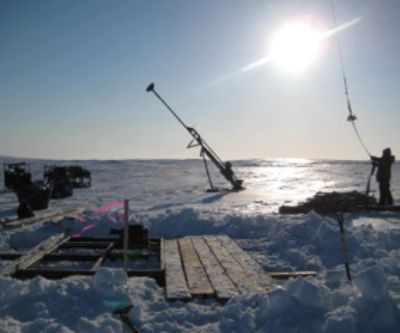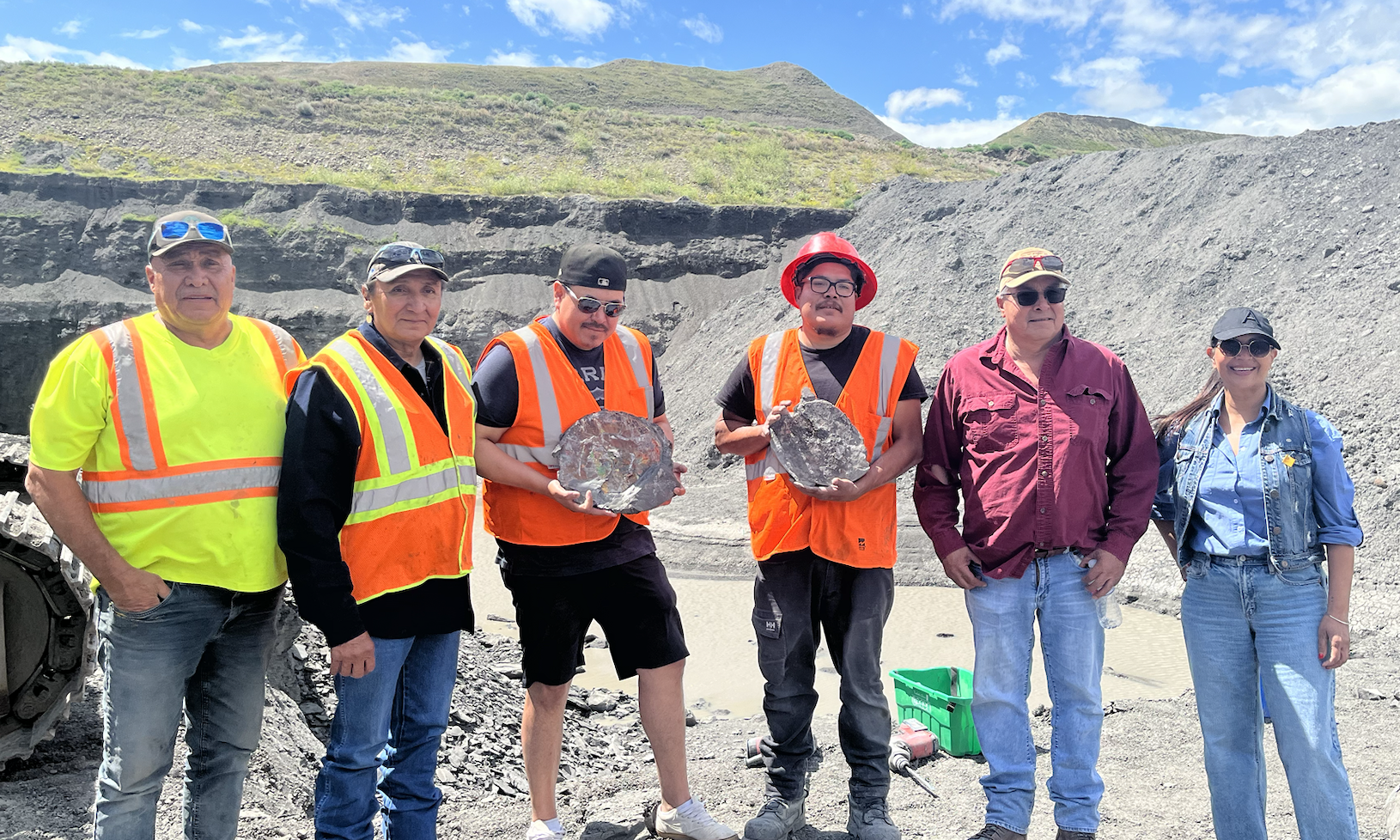Drilling diamond dreams in Canada’s North

It was like a scene from an Indiana Jones movie. After the engine failed, the helicopter plunged into a rain forest canopy. But the dense vegetation prevented the crippled machine from crashing to earth, sparing the lives of those on board.
Among its three occupants was a young geologist called Buddy Doyle, who found himself hanging upside down in the upturned helicopter. The pilot was badly injured. So Doyle grabbed the damaged radio and blurted out a call for help. The survivors spent the night huddled in the cockpit hoping and praying that someone had heard their distress call. Fortunately, they were plucked to safety by a helicopter crew from a rival company the following day.
Doyle’s brush with disaster happened more than 20 years ago when he was working for mining giant Rio Tinto Plc, exploring for gold in remote Papua New Guinea. But his nightmarish ordeal wasn’t for nothing. He was eventually credited with discovering one of the world’s richest gold finds, the Lihir mine, which has produced well more than 20 million ounces of gold to date.
As his reward for years of toiling in steaming jungle terrain, where he suffered bouts of malaria and foot rot, Dolye was hurried off to a place that seemed like a different planet in comparison — Canada’s frozen northern tundra.
This is where his sharp geological acumen and dogged determination served him well once again. As an exploration manager for Kennecott Canada Exploration Inc. — a subsidiary of Rio Tinto PLC — his assignment was to make a world-class diamond discovery. Which was no easy task in the barren, frozen vastness of the Northwest Territories (NWT).
However, he eventually overcame daunting odds to locate what later became the multi-billion-dollar Diavik diamond mine. For his efforts, he was paid a measly $5,000 bonus.
After watching others get rich from this spectacular find, Doyle decided it was time to strike out on his own. And if he was going to continue risking life and limb, he might as well be better compensated, he figured. So he joined a small diamond exploration mining junior called Arctic Star Exploration Corp.
For close to a decade, he has been trying to recapture the glory of his earlier geological successes. But it’s been a tough slog — literally and figuratively. Malaria and foot rot have been replaced with hypothermia and frostbite. And a succession of hot leads in frigid locations have disappointed time and time again. But he now believes that he may finally be on the verge of striking pay dirt — once more.
He’s not alone in his assessment. Even Chuck Fipke likes what he sees. Fipke is a famed geologist who reputedly became an over-night billionaire. Which was after he discovered in 1991 what evolved into Canada’s first-ever diamond mine. Ironically, this epic find was the catalyst for Rio Tinto’s decision to rush Doyle to Canada to seek out a similar diamond bonanza.
In recent times, Fipke’s laboratory in Kelowna, B.C., has processed some of the exploration data for Arctic Star (TSX.V: ADD) — a TSX Venture Exchange publicly-traded company.
A specialist in the field of geochemistry, Fipke relied extensively on this geological sleuthing technique to track down the source of what later became the Ekati diamond mine in Canada’s Northwest Territories (NWT).
This gives Fipke a privileged insight into the prospects of success for Arctic Star’s best drill targets (known in geospeak as a “high-priority anomalies”), which are in the same NWT region as Ekati. The primary target was selected, in part, because of its excellent geochemistry. This means it is ideally located at the head of a prolific “dispersion train” of diamond indicator minerals (one that also includes tiny diamonds).
“It looks like the geochemistry is coming from the area where the anomaly is,” Fipke says. “It’s definitely worth drilling, for sure.”
In other words, the approximately 40-kilometre-long indicator mineral trail comes to an abrupt end in the immediate vicinity of Arctic Star’s initial high-priority drill target. This situation is comparable to a trail of crumbs leading back to a loaf of bread.
Even though Arctic Star’s upcoming drill program — which is scheduled to commence this week — will cost around a million dollars, it may end up being a small price to pay. Especially considering that an economic discovery would make this upstart company the toast of Canada’s mining investment community. After all, the NWT’s three diamond mines have collectively produced over $25 billion worth of these glittering gems so far.
With so much at stake, Arctic Star isn’t pinning its hopes on just one target, alone. A cluster of other stand-out anomalies — many of which exhibit very encouraging geophysical signatures — will also be drill-tested. Hence, an opportunity to unearth the world’s next big-league diamond discovery represents a potential home-run for Arctic Star’s investors.
But it would be premature to put the champagne on ice just yet. The fact is diamond dreams and the harsh realities of mineral exploration don’t make good bedfellows. For instance, over 100 junior diamond exploration companies have spent an estimated $300 million-plus on scouring the NWT and other remote regions of Canada over the last two decades. So says John Kaiser, who has been a mining newsletter writer (www.kaiserbottomfish.com) for over 20 years.
“There’s less than a dozen diamond exploration juniors left, just because the odds of success have always been dismal,” he says.
His assessment is hard to argue with. Other than each spending millions of dollars and thousands of hours of work, the vast majority of these intrepid exploration companies have one important common denominator: They’ve come up empty-handed.
However, there have been several phenomenal success stories to make it all worthwhile for plenty of investors. They include Fipke’s Dia Met Minerals, which discovered the Ekati mine. This fabulous find propelled the company’s share price from mere pennies in 1991 to over $67 the following year.
Next came another junior mining rags-to-riches story — Aber Resources. Its share price had a similarly meteoric run after the company discovered what became the Diavik mine. Last but not least, Winspear Resources also struck the geological jackpot when it unearthed a diamond deposit that became the Snap Lake mine. Its shareholders also enjoyed a “home run” return on their investments.
Another small-time player that won big — Mountain Province Diamonds — is still awaiting a government-issued mining permit to fulfill its glittering destiny at Kennedy Lake in the NWT.
The good news for Arctic Star shareholders is that diamond deposits, known as kimberlite pipes, often occur in clusters that resemble a shotgun blast spread out over an area in diameter of up to 50 kilometres. So when one of them is located, geologists know that other potentially diamond-rich kimberlite pipes are likely relatively nearby.
But what exactly is a kimberlite pipe? It’s actually an ancient volcanic eruption of molten rock that has hardened into a vertical carrot-shaped structure. Having emerged from the bowels of the earth, some of these formations transported diamonds to the earth’s surface hundreds of millions of years ago. And a small percentage of them have become virtual treasure troves that are each worth billions of dollars.
In Canada’s far north, these kimberlite eruptions left fingerprints in the form of indicator minerals. Which were dispersed like volcanic ash in the general vicinity of the pipes’ cratered surfaces. Hence, diamond explorationists know they’re on the right track when they’re able to trace these tell-tale indicator mineral trails to their diamondiferous source.
In the case of Arctic Star, finding one or more diamond-laced pipes is only half the battle. The next step would be to perform a mini bulk sample of some of the near-surface rock. Which would provide a very rough estimate of the dissemination of diamonds in a pipe, as well as their average size and quality. It typically takes at least a carat per tonne of rock to generate odds that favour a viable mine becoming a reality.
Once again, the rewards can be dazzling. For instance, NWT’s existing diamond mines can each yield as many as 10 million carats a year. And they’re always in hot demand — far more so than other highly valuable commodities. For instance, whereas the price of gold can fluctuate wildly, diamond prices have been steadily trending upwards for decades.
As the ultimate status symbol, diamonds are particularly popular these days among the world’s emerging super-economies, like China and Russia. Which continue to produce newly-minted millionaires at an astounding rate.
In spite of this recession-proof growing demand for the world’s most prestigious luxury good, there’s a catch for Canada: Our supplies are already dwindling. In fact, there’s only been one economic diamond discovery in Canada in well over a decade. And that was De Beers’ Victor pipe in Ontario. It’s the only diamond mine outside of the NWT.
Therefore, a new discovery may be long overdue.
But why does Arctic Star believe it has a better shot at the big time than the vast majority of its past and present peers in Canada’s diamond exploration sweepstakes? Doyle believes he can answer this question.
According to the soft-spoken but affable Australian, the geochemistry that has led Arctic Star to its highest-priority drill target is quite exceptional.
“The abundant indicator minerals in the South Coppermine mineral train have the same unique chemistry as ones that co-exist with diamonds. In other words, they must have been formed under the exact same conditions that create diamonds,” he says. “This makes it probable that the source of these trace elements is diamondiferous.”
Doyle is a man on a mission as he intently studies an array of table-top-sized maps of Arctic Star’s upcoming drill targets in his cluttered, unpretentious Vancouver office. As one of the world’s foremost diamond exploration experts, he’s convinced that the NWT has at least one more dazzling secret to give up. And he believes this time around his odds of success are particularly encouraging.
“The depth of experience and level of sophistication that we have in finding diamond pipes has come a long way since the Diavik and Ekati diamond mines were found,” Doyle says. “Whereas these past discoveries were largely reliant on using one particular exploration tool or another, we’re now using all the tools in the tool kit.”
“And these exploration techniques that we’ve used to identify our best drill targets each corroborate one other. Which is really exciting.”
Image courtesy Arctic Star Exploration Corp.
More News
{{ commodity.name }}
{{ post.title }}
{{ post.date }}

Comments